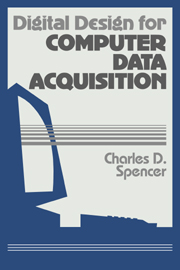Book contents
- Frontmatter
- Contents
- Preface
- 1 Computer Measurement
- 2 Introduction to Digital Electronics
- 3 Parallel I/O Ports
- 4 Tutorial on the AD573 ADC
- 5 Tutorial on the 6264 RAM
- 6 Tutorial on the Intel 8253 PIT
- 7 Control/Data Interface
- 8 ADC Module
- 9 Comprehensive Measurement System
- 10 Fast Voltage Measurer
- Appendix A References
- Appendix B Vendors
- Appendix C IC Pin Assignments
- Appendix D IBM Paralel Ports
- Appendix E Apple II Parallel Ports
- Appendix F Computer Architecture
- Index
4 - Tutorial on the AD573 ADC
Published online by Cambridge University Press: 10 November 2009
- Frontmatter
- Contents
- Preface
- 1 Computer Measurement
- 2 Introduction to Digital Electronics
- 3 Parallel I/O Ports
- 4 Tutorial on the AD573 ADC
- 5 Tutorial on the 6264 RAM
- 6 Tutorial on the Intel 8253 PIT
- 7 Control/Data Interface
- 8 ADC Module
- 9 Comprehensive Measurement System
- 10 Fast Voltage Measurer
- Appendix A References
- Appendix B Vendors
- Appendix C IC Pin Assignments
- Appendix D IBM Paralel Ports
- Appendix E Apple II Parallel Ports
- Appendix F Computer Architecture
- Index
Summary
The approach to data acquisition described in this book utilizes three categories of large scale integrated circuits: Analog-to-Digital Converters (ADC's), Random Access Memories (RAM's), and Programmable Interval/Timers (PIT's). The specific IC's are the Analog Devices AD573 10-bit ADC, the 6264 8K by 8-bit RAM and the Intel 8253 PIT. The purpose of this and the following two chapters is to describe these integrated circuits in detail, to show how they can be interfaced to the parallel ports of Chapter 3 and to present all hardware and software for example applications. While these tutorials focus on particular devices, the ideas and principles can be applied to other ADC's, memories and PIT's, as well as to other types of devices (including voltage-to-frequency converters, digital-to-analog converters, programmable gain amplifiers, digital switches, etc.).
A variety of sensors produce voltages precisely related to such physical quantities as temperature, pressure, light intensity, current, etc. For a computer to get information from sensors, voltages must be converted to digital codes, something most efficiently done by an ADC. While this chapter only shows how to interface and control an ADC through the parallel ports, several references in Appendix A provide general discussions of sensors, operational amplifiers and the internal operation of converters.
ADC's are characterized by an input voltage range, conversion time and resolution (the number of binary bits in the converted value). The Analog Devices AD573JN is a $20, 10-bit, 20μsec converter which accepts input voltages in one of two ranges, bipolar -5 to +5 or unipolar 0 to +10. The AD573 was chosen because its speed and 10-bit resolution are needed for applications in later chapters.
- Type
- Chapter
- Information
- Digital Design for Computer Data Acquisition , pp. 85 - 99Publisher: Cambridge University PressPrint publication year: 1990



